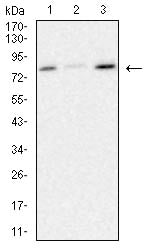
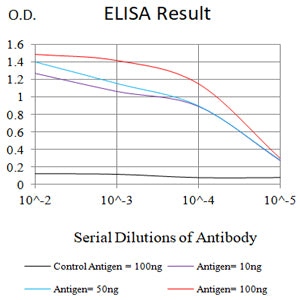
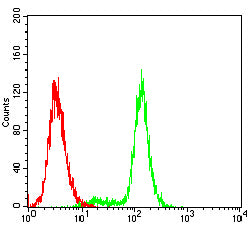
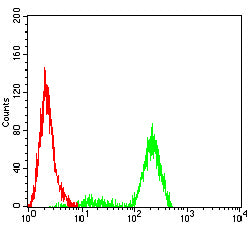
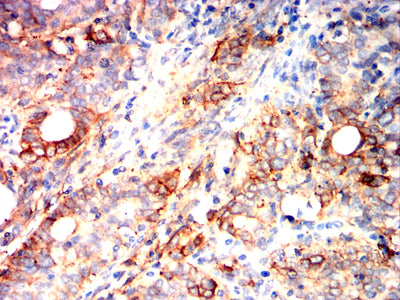
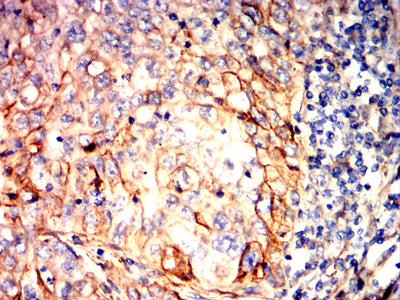
| WB | 1/500 - 1/2000 | Human,Mouse,Rat |
| IF | 咨询技术 | Human,Mouse,Rat |
| IHC | 1/200 - 1/1000 | Human,Mouse,Rat |
| ICC | 技术咨询 | Human,Mouse,Rat |
| FCM | 1/200 - 1/400 | Human,Mouse,Rat |
| Elisa | 1/10000 | Human,Mouse,Rat |
| Aliases | CLA1; SRB1; CLA-1; SR-BI; CD36L1; HDLQTL6 |
| Entrez GeneID | 949 |
| clone | 5E9H10 |
| WB Predicted band size | 60.8kDa |
| Host/Isotype | Mouse IgG2a |
| Antibody Type | Primary antibody |
| Storage | Store at 4°C short term. Aliquot and store at -20°C long term. Avoid freeze/thaw cycles. |
| Species Reactivity | Human |
| Immunogen | Purified recombinant fragment of human SCARB1 (AA: Extra(33-232)) expressed in E. Coli. |
| Formulation | Purified antibody in PBS with 0.05% sodium azide |
+ +
以下是3篇与SCARB1抗体相关的参考文献,按研究领域分类概述:
---
### 1. **脂代谢与动脉粥样硬化**
**文献名称**:*SR-B1 mediates neutral lipid sorting and targeted cholesterol delivery in hepatocytes*
**作者**:Wüstner D. et al. (2020)
**摘要**:该研究利用SCARB1特异性抗体,通过免疫荧光和Western blot验证肝细胞中SR-B1(SCARB1蛋白)的定位,发现其通过中性脂质分选机制调控胆固醇向胆汁的定向运输,揭示了SR-B1缺陷可能加剧动脉粥样硬化的分子机制。
---
### 2. **病毒感染机制**
**文献名称**:*HDL-scavenger receptor B1 facilitates SARS-CoV-2 entry*
**作者**:Wei C. et al. (2021)
**摘要**:研究采用抗SCARB1的中和抗体阻断实验,证明SARS-CoV-2病毒通过结合宿主细胞表面的SR-B1蛋白(HDL受体)增强感染效率,提示靶向SCARB1的抗体可能作为抗病毒治疗的潜在策略。
---
### 3. **肿瘤微环境调控**
**文献名称**:*Scavenger receptor class B type 1 suppresses肝癌进展 via modulating lipid metabolism*
**作者**:Li Y. et al. (2019)
**摘要**:通过免疫组化(使用SCARB1单克隆抗体)分析肝癌组织样本,发现SCARB1低表达与肿瘤转移及不良预后相关,机制研究表明其通过调节脂代谢重编程抑制肿瘤微环境中的炎症信号通路。
---
**备注**:以上文献可通过PubMed或期刊官网检索原文。如需更早期研究或特定实验方法(如流式细胞术应用),可进一步补充。
The scavenger receptor class B type 1 (SCARB1), also known as SR-BI, is a cell surface glycoprotein that plays a critical role in cholesterol metabolism, particularly in mediating the uptake of high-density lipoprotein (HDL)-derived cholesterol and cholesteryl esters into cells. SCARB1 antibodies are essential tools for studying its expression, localization, and function in various tissues, including the liver, adrenal glands, and endothelial cells. These antibodies are widely used in techniques such as Western blotting, immunohistochemistry, flow cytometry, and immunofluorescence to investigate SCARB1's involvement in lipid transport, atherosclerosis, and metabolic disorders.
Research using SCARB1 antibodies has highlighted its dual role in health and disease. While it promotes reverse cholesterol transport (protecting against cardiovascular disease), its overexpression in certain cancers may facilitate tumor progression by enhancing lipid uptake. Antibodies targeting specific epitopes or post-translational modifications of SCARB1 help elucidate its interaction partners, regulatory mechanisms, and therapeutic potential. Species-specific SCARB1 antibodies (e.g., human, mouse, rat) enable cross-species comparative studies. Validation of antibody specificity through knockout controls remains crucial, given structural similarities within the scavenger receptor family. Ongoing studies continue to explore SCARB1's link to viral entry pathways and inflammatory responses, expanding its biomedical relevance.
×